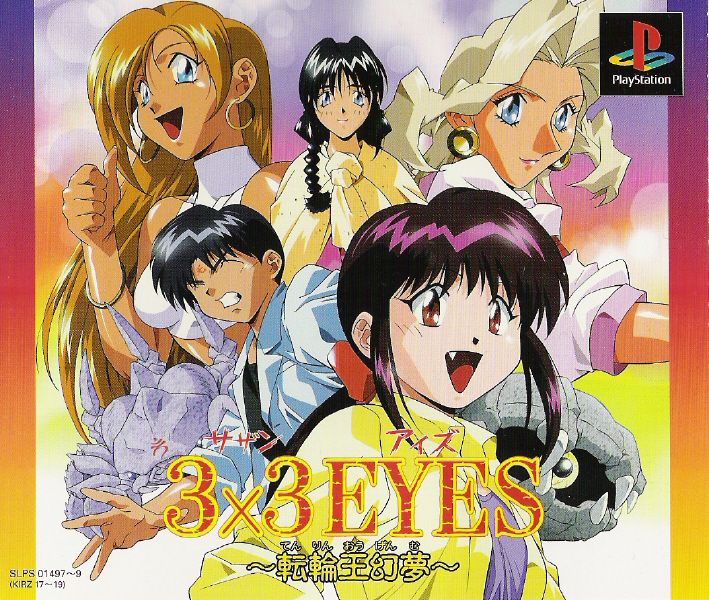Retro Replay Review
Gameplay
3×3 Eyes: Tenrin Ō Genmu delivers a unique take on the adventure genre by blending traditional Japanese interactive storytelling with a point-and-click interface. Instead of a command menu, players guide a cursor across static backgrounds to investigate objects, engage in conversations, and trigger hidden events. This system feels intuitive, allowing for seamless exploration of richly drawn environments without tedious menu navigation. The simplicity of the cursor mechanics ensures the pacing remains brisk, keeping narrative momentum at the forefront.
(HEY YOU!! We hope you enjoy! We try not to run ads. So basically, this is a very expensive hobby running this site. Please consider joining us for updates, forums, and more. Network w/ us to make some cash or friends while retro gaming, and you can win some free retro games for posting. Okay, carry on 👍)
The game eschews complex puzzles in favor of narrative-driven interactions. While some players might miss the brainteasers typical of western adventures, Tenrin Ō Genmu makes up for this by weaving story revelations directly into exploration. Every highlighted object or character reaction advances the plot, so exploration always feels meaningful. Dialogue choices are limited but impactful, occasionally opening alternate dialogue branches that shed light on character motivations and deepen immersion.
Cutscenes play a central role in gameplay flow, punctuating exploration segments with fully animated sequences. These anime-style interludes do more than advance the narrative—they reward player curiosity by unveiling hidden facets of the story. Whether you’re searching an abandoned temple or walking along the Ganges, the balance between interactive stills and dynamic animations creates an “interactive anime” experience that will appeal to fans seeking a more narrative-focused title.
Graphics
Visually, Tenrin Ō Genmu pays homage to its manga and anime roots through meticulously crafted character portraits and background art. The static screens showcase hand-drawn locations—from bustling Tokyo cafés to mystical Indian ruins—with vibrant colors and intricate linework. Even though these backdrops don’t animate in real time, subtle details like drifting dust motes or flickering lanterns give life to each scene without breaking the still-image style.
The animated cutscenes are the highlight of the graphical presentation. Studio-quality animation sequences depict high-stakes confrontations and emotional character moments with fluid movement and dynamic camera angles. Facial expressions and body language are rendered faithfully to the original anime, capturing Pai’s childlike wonder and Yakumo’s reluctant heroism. These sequences feel like episode snippets from a mini-series, rewarding fans with familiar visuals and newcomers with polished production values.
The user interface complements the anime aesthetic with minimalist icons and cursors that blend into the background, ensuring immersion remains uninterrupted. Interactive hotspots glow subtly when hovered over, guided by context-sensitive labels such as “look” or “talk.” While modern adventure games boast 3D environments or high-resolution effects, Tenrin Ō Genmu’s stylistic choice of 2D art retains a timeless charm that resonates with aficionados of classic Japanese gaming.
Story
At its core, Tenrin Ō Genmu tells the compelling tale of Yakumo, an ordinary teenager thrust into a cosmic conflict after becoming Pai’s unwitting Wu servant. The narrative weaves mythological elements from the sanzhiyan legend—three-eyed immortals corrupted into demon-like beings—with human drama and personal sacrifice. This blend of supernatural lore and grounded emotion elevates the plot, giving each chapter weight as Yakumo and Pai journey across the globe seeking redemption and humanity.
The characterization shines through in both on-screen dialogue and cutscenes. Pai’s centuries-old wisdom contrasts sharply with her childlike curiosity, creating poignant moments when she confronts the horrors wrought by her own kind. Yakumo’s evolution from reluctant waiter to determined ally underscores the game’s themes of loyalty and self-discovery. Side characters, including the malevolent Benares and the enigmatic ruler Kaiyanwang, each bring unique motivations and moral ambiguity, making every confrontation more than just a physical battle.
Exploration serves as a narrative device: visiting India’s temples or Easter Island’s statues reveals fragments of Pai’s shattered past and the sanzhiyan’s dark legacy. Environmental storytelling fills gaps between animated scenes, encouraging players to piece together the broader mythos. Although dialogue options are limited, the emotional resonance remains strong, ensuring that every discovery—whether in text or art—deepens investment in the protagonists’ quest for humanity.
Overall Experience
3×3 Eyes: Tenrin Ō Genmu is a niche gem for fans of the source material and adventure aficionados drawn to story-first gameplay. Its streamlined interface, reliance on animated cutscenes, and absence of complex puzzles might not suit players seeking cerebral challenges, but the game compensates with a well-paced narrative and striking visuals. The interactive anime format stands out in a crowded market, offering a refreshing alternative to more conventional point-and-click adventures.
Immersion remains the game’s strongest asset. The cursor-based interactions encourage thorough examination of each beautifully illustrated location, while the high-quality cutscenes deliver cinematic thrills reminiscent of the original 3×3 Eyes anime. Travelers across time zones and mythological realms feel authentically realized, drawing players into Pai and Yakumo’s perilous journey. The balance between exploration and animation ensures that the story always takes center stage.
Ultimately, Tenrin Ō Genmu succeeds by focusing on what it does best: telling an emotionally rich, visually enchanting tale of immortality, friendship, and redemption. Whether you approach it as a long-time fan or a newcomer to the 3×3 Eyes universe, you’ll find a heartfelt adventure that honors its manga roots while standing on its own merits. For gamers seeking a narrative-driven experience with a distinctive Japanese flair, this title is well worth exploring.
 Retro Replay Retro Replay gaming reviews, news, emulation, geek stuff and more!
Retro Replay Retro Replay gaming reviews, news, emulation, geek stuff and more!









Reviews
There are no reviews yet.